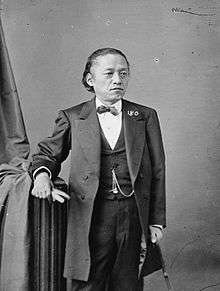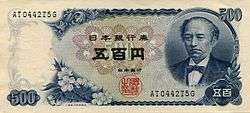Iwakura Tomomi
| Iwakura Tomomi 岩倉 具視 | |
|---|---|
 Iwakura Tomomi wearing western clothing | |
| Born |
October 26, 1825 Kyoto, Japan |
| Died |
July 20, 1883 (aged 57–58) Tokyo, Japan |
| Nationality | Japanese |
| Occupation | Politician |
| Known for | Leading the Iwakura Mission |
Iwakura Tomomi (岩倉 具視, October 26, 1825 – July 20, 1883) was a Japanese statesman during the Bakumatsu and Meiji period.[1] The former 500 Yen banknote issued by the Bank of Japan carried his portrait.
Early life
Iwakura was born in Kyoto as the second son of a low-ranking courtier and nobleman Horikawa Yasuchika (堀川 康親); through his mother, he was a first cousin of Emperor Ninkō.[2] In 1836 he was adopted by another nobleman, Iwakura Tomoyasu (岩倉 具康), from whom he received his family name. He was trained by the kampaku Takatsukasa Masamichi and wrote the opinion for the imperial Court reformation. In 1854 he became a chamberlain to Emperor Kōmei, his first cousin once removed.
As court noble
As with most other courtiers in Kyoto, Iwakura opposed the Tokugawa shogunate's plans to end Japan's national isolation policy and to open Japan to foreign countries. When Hotta Masayoshi, a Rōjū of the Tokugawa government came to Kyoto to obtain imperial permission to sign the Treaty of Amity and Commerce (United States–Japan) in 1858, Iwakura gathered courtiers who opposed the treaty and attempted to hinder negotiations between the Shōgun and the Court.
After Tairō Ii Naosuke was assassinated in 1860, Iwakura supported the Kobugattai Movement, an alliance of the Court and the Shogunate. The central policy of this alliance was the marriage of the Shōgun Tokugawa Iemochi and Princess Kazu-no-Miya Chikako, the younger sister of the Emperor Kōmei. Samurai and nobles who supported the more radical Sonnō jōi policy saw Iwakura as a supporter of the Shogunate, and put pressure on the Court to expel him. As a result, Iwakura left the Court in 1862 and moved to Iwakura, north of Kyoto.
In exile
In Iwakura he wrote many opinions and sent them to the Court or his political companions in Satsuma Domain. In 1866 when Shōgun Iemochi died, Iwakura attempted to have the Court seize political initiative. He tried to gather daimyō under the name of the Court but failed. When the Emperor Kōmei died the next year, there was a rumor Iwakura had plotted to murder the emperor with poison, but he escaped arrest.
With Ōkubo Toshimichi and Saigō Takamori, on January 3, 1868, he engineered the seizure of the Kyoto Imperial Palace by forces loyal to Satsuma and Chōshū, thus initiating the Meiji Restoration. He commissioned Imperial banners with the sun and moon on a red field, which helped ensure that the encounters of the Meiji Restoration were generally bloodless affairs.
Meiji bureaucrat

After the establishment of the Meiji government, Iwakura played an important role due to the influence and trust he had with Emperor Meiji. He was largely responsible for the promulgation of the Five Charter Oath of 1868, and the subject abolition of the han system.
Soon after his appointment as Minister of the Right in 1871, he led the two-year around-the-world journey known as the Iwakura mission, visiting the United States and several countries in Europe with the purpose of renegotiating the unequal treaties and gathering information to help effect the modernization of Japan. A celebration was held in Manchester and Liverpool in 1997 to celebrate the 125th anniversary of the Iwakura Mission. On his return to Japan in 1873, he was just in time to prevent an invasion of Korea (Seikanron). Realizing that Japan was not in any position to challenge the western powers in its present state, he advocated strengthening the imperial institution, which he felt could be accomplished through a written constitution and a limited form of parliamentary democracy. He ordered Inoue Kowashi to begin work on a constitution in 1881, and ordered Itō Hirobumi to Europe to study various European systems.
Death
Although in poor health by early 1883, Iwakura went to Kyoto in May to direct efforts to restore and preserve the imperial palace and the buildings of the old city, many of which had been falling into disrepair since the transfer of the capital to Tokyo. Soon however, he became seriously ill and was confined to his bed. The Meiji Emperor sent his personal physician, Erwin Bälz, to examine Iwakura; Baelz diagnosed advanced throat cancer. The emperor personally visited his cousin and old friend on July 19, and was moved to tears at his condition. Iwakura died the following day, and was given a state funeral, the first ever given by the imperial government.
Honours

From the corresponding article in the Japanese Wikipedia
- Grand Cordon of the Order of the Rising Sun (29 December 1876)
- Grand Cordon of the Order of the Chrysanthemum (1 November 1882)
Order of precedence
- Junior fifth rank (28th day, 10th month of the ninth year of Tenpo (1838))
- Fifth rank (Fourth day, sixth month of the 12th year of Tenpo (1841))
- Senior fifth rank (18th day, second month of the second year of Koka (1845))
- Fourth rank (10th day, sixth month of the seventh year of Ansei (1854))
- Senior fourth rank (Fifth day, first month of the second year of Man'en (1861))
- Third rank (Second day, second month of the fourth year of Keio (1868))
- Senior second rank (25th day, first month of the second year of Meiji (1869))
- First rank (18 May 1876)
- Senior first rank (20 July 1885; posthumous)
Ancestry
| Ancestors of Iwakura Tomomi | |||||||||||||||||||||||||||||||||||||||||||||||||||||||||||||||||||||||||||||||||||||||||||||||||||||||||||||||||||||||||||||||||||||||||||||||||||||||||||||||||||||||||||||||||||||||||||||||||||||||||||||||||||||||||||||||||||||||||||||||||||||||||||||||||||||||||||||||||||||||||||||||||||||||||||||||||||||||||||||||||||||||||||||||||||||||||||||||||||||||||||||||||||||||||||||||||||||||||||||||||||||||||||||||||||||||||||||||||||||||||||||||||||||||||||||||||||
|---|---|---|---|---|---|---|---|---|---|---|---|---|---|---|---|---|---|---|---|---|---|---|---|---|---|---|---|---|---|---|---|---|---|---|---|---|---|---|---|---|---|---|---|---|---|---|---|---|---|---|---|---|---|---|---|---|---|---|---|---|---|---|---|---|---|---|---|---|---|---|---|---|---|---|---|---|---|---|---|---|---|---|---|---|---|---|---|---|---|---|---|---|---|---|---|---|---|---|---|---|---|---|---|---|---|---|---|---|---|---|---|---|---|---|---|---|---|---|---|---|---|---|---|---|---|---|---|---|---|---|---|---|---|---|---|---|---|---|---|---|---|---|---|---|---|---|---|---|---|---|---|---|---|---|---|---|---|---|---|---|---|---|---|---|---|---|---|---|---|---|---|---|---|---|---|---|---|---|---|---|---|---|---|---|---|---|---|---|---|---|---|---|---|---|---|---|---|---|---|---|---|---|---|---|---|---|---|---|---|---|---|---|---|---|---|---|---|---|---|---|---|---|---|---|---|---|---|---|---|---|---|---|---|---|---|---|---|---|---|---|---|---|---|---|---|---|---|---|---|---|---|---|---|---|---|---|---|---|---|---|---|---|---|---|---|---|---|---|---|---|---|---|---|---|---|---|---|---|---|---|---|---|---|---|---|---|---|---|---|---|---|---|---|---|---|---|---|---|---|---|---|---|---|---|---|---|---|---|---|---|---|---|---|---|---|---|---|---|---|---|---|---|---|---|---|---|---|---|---|---|---|---|---|---|---|---|---|---|---|---|---|---|---|---|---|---|---|---|---|---|---|---|---|---|---|---|---|---|---|---|---|---|---|---|---|---|---|---|---|---|---|---|---|---|---|---|---|---|---|---|---|---|---|---|---|---|---|---|---|---|---|---|---|---|---|---|---|---|---|---|---|---|---|---|---|---|---|---|---|---|---|---|---|---|---|---|---|---|---|---|---|---|---|---|---|---|---|---|---|---|---|---|---|---|---|---|---|---|---|---|---|---|---|---|---|---|---|---|---|---|---|---|---|---|---|---|---|---|---|---|---|---|---|---|---|---|---|
| |||||||||||||||||||||||||||||||||||||||||||||||||||||||||||||||||||||||||||||||||||||||||||||||||||||||||||||||||||||||||||||||||||||||||||||||||||||||||||||||||||||||||||||||||||||||||||||||||||||||||||||||||||||||||||||||||||||||||||||||||||||||||||||||||||||||||||||||||||||||||||||||||||||||||||||||||||||||||||||||||||||||||||||||||||||||||||||||||||||||||||||||||||||||||||||||||||||||||||||||||||||||||||||||||||||||||||||||||||||||||||||||||||||||||||||||||||
Notes
- ↑ Nussbaum, Louis-Frédéric. (2005). "Iwakura Tomomi" in Japan Encyclopedia, p. 408, p. 408, at Google Books.
- 1 2 "Iwakura genealogy". Reichsarchiv. Retrieved 11 September 2017. (in Japanese)
References
- Beasley, William G. (1972). The Meiji Restoration. Stanford: Stanford University Press. ISBN 9780804708159; OCLC 579232
- Hane, Mikiso. Modern Japan: A Historical Survey. Westview Press (2001). ISBN 0-8133-3756-9
- Jansen, Marius B. and Gilbert Rozman, eds. (1986). Japan in Transition: from Tokugawa to Meiji. Princeton: Princeton University Press. ISBN 9780691054599; OCLC 12311985
- Nish, Ian. (1998) The Iwakura Mission to America and Europe: A New Assessment. Richmond, Surrey: Japan Library. ISBN 9781873410844; ISBN 0415471796; OCLC 40410662
- Nussbaum, Louis-Frédéric and Käthe Roth. (2005). Japan encyclopedia. Cambridge: Harvard University Press. ISBN 978-0-674-01753-5; OCLC 58053128
- Sims, Richard L. (2001). Japanese Political History Since the Meiji Renovation 1868–2000. New York: Palgrave Macmillan. ISBN 9780312239145; ISBN 9780312239152; OCLC 45172740
External links
| Wikimedia Commons has media related to: |
- National Diet bio & portrait
- Meiji Dignitaries is a portrait of Tomomi and others from 1877